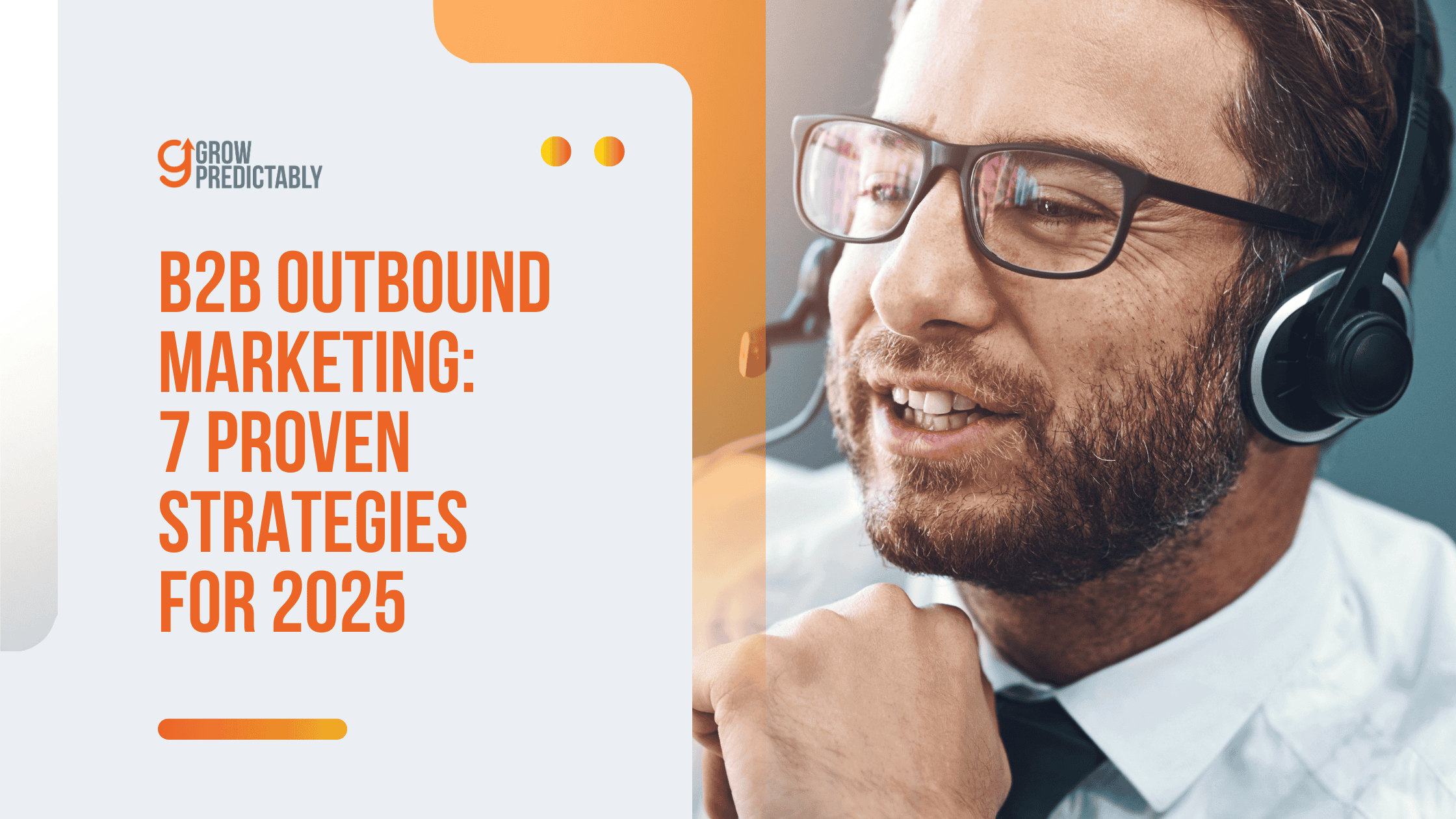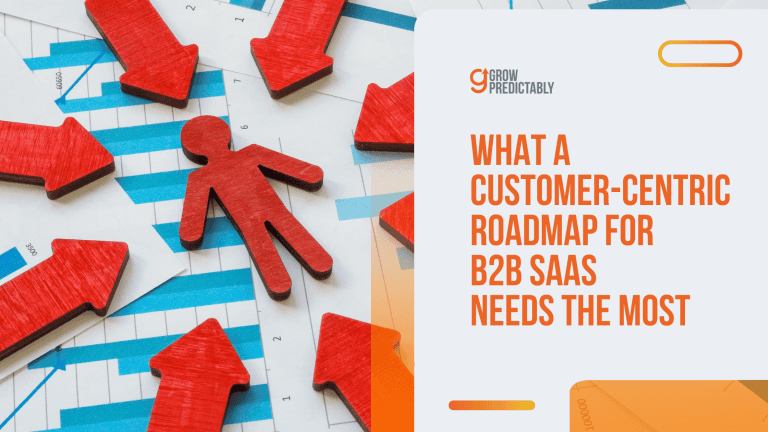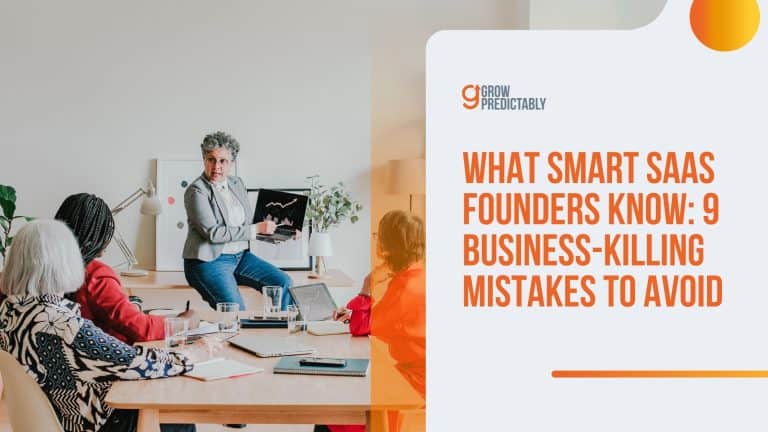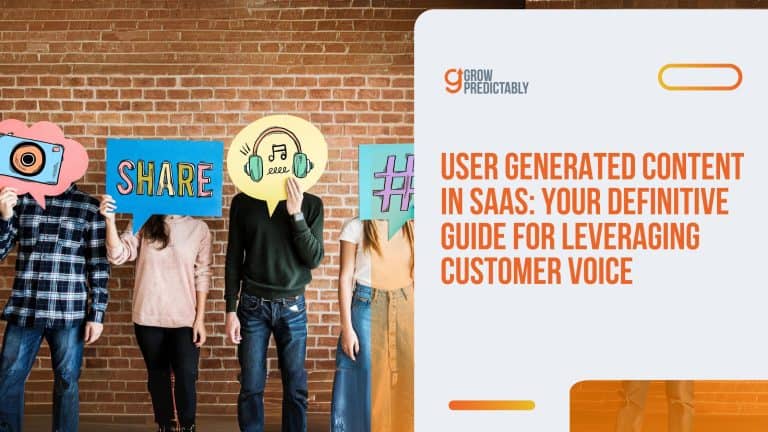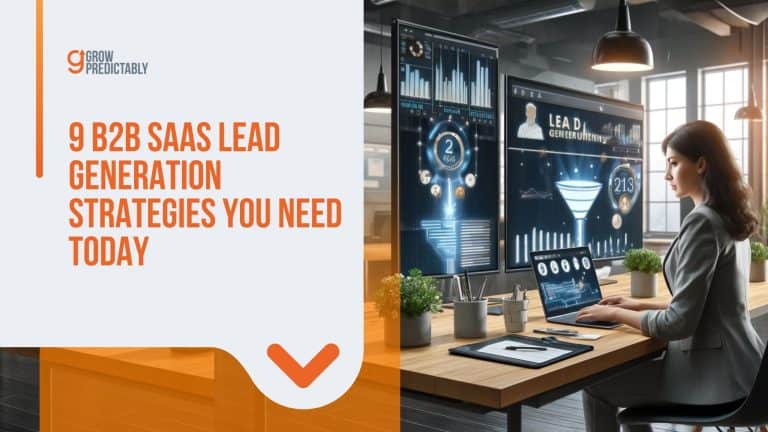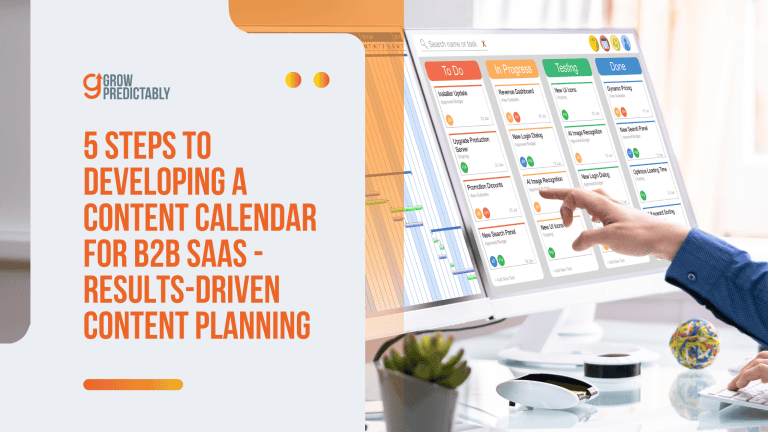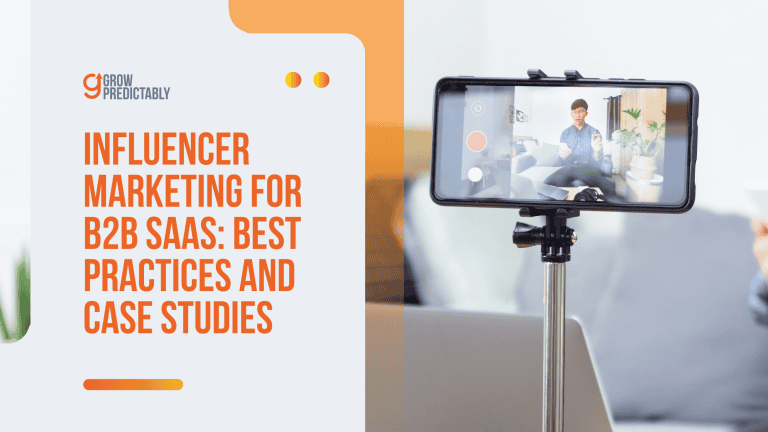B2B Outbound Marketing: 7 Proven Strategies for 2025
B2B outbound marketing is at a turning point.
Ignore the shift, and you’ll sink time and resources into campaigns that barely get noticed.
But adapt, and the opportunities are huge—multi-channel orchestration and AI tools are turning outreach into a precision game.
Don’t believe it?
Let’s break down exactly what the best in the game are doing differently—and how you can elevate your outbound marketing strategy.

1. Leveraging CRM for Robust B2B Outbound Marketing
Picture this: A software company was blasting 10,000 identical emails monthly, getting a measly 0.5% response rate.
After implementing Salesforce with smart segmentation, their response rate jumped to 7% – sending fewer but better-targeted messages.
CRM systems aren’t just contact databases – they’re your secret weapon for implementing advanced outbound marketing techniques.
Here’s the real deal on making them work:
- Smart Segmentation That Actually Works
- Tag accounts by industry vertical, company size, and past interactions
- Build dynamic lists based on engagement patterns
- Set up automatic scoring based on website visits and email opens
- Personalization (Without Being Creepy)
- Track buying signals through page visits and content downloads
- Use interaction history to customize follow-up timing
- Automate personalized content sharing based on prospect interests
- Power Moves With Data
- Monitor engagement patterns to identify prime contact times
- Track which message types resonate with specific segments
- Use A/B testing data to refine messaging continuously
- Integration Magic

- Connect your CRM with LinkedIn Sales Navigator for enhanced targeting
- Sync with marketing automation tools for seamless workflows
- Import intent data to spot companies actively searching for solutions
Pro tip: Have your sales team set up custom fields to track specific pain points mentioned in sales calls. This intel becomes gold for personalizing future outreach.
Next up: We’ll explore how AI tools can supercharge your CRM data for even better targeting.
But first, make sure you’ve nailed these CRM basics – they’re the foundation everything else builds on.
Now that you’ve got your CRM foundation set up, let’s see how LinkedIn and Copilot AI can automate your personalized outreach efforts.
2. Utilizing LinkedIn and Copilot AI for Automated Outreach
LinkedIn’s data shows personalized automated messages get 3x more responses than generic ones – and Copilot AI helps nail this at scale.
Here’s the real deal on making these tools work together:
First, let’s clear up a common myth: automation doesn’t mean spammy.
Copilot AI reads LinkedIn profiles and adapts outreach based on job titles, company details, and shared connections.
This means your messages hit the mark every time.
The smart approach combines three key outbound marketing techniques:
- Profile-Based Targeting
- Use Copilot AI to scan for ideal customer profiles
- Filter by industry, company size, and job titles
- Build targeted lists based on engagement patterns
- Smart Message Customization
- Write base templates that feel human
- Let Copilot AI insert relevant details from prospects’ profiles
- Test different approaches with A/B splits
- Follow-up Automation
- Set up 3-4 touch sequence over 2 weeks
- Mix LinkedIn messages with connection requests
- Track response rates to optimize timing
Pro tip: Start with a small batch of 50 contacts. Test your message sequences, measure results, then scale what works.
Remember: LinkedIn’s algorithm watches for spam patterns. Space out your automated outreach and keep messages conversational. Quality beats quantity every time.
Next up: Turning these conversations into actual sales opportunities through proper lead nurturing…
With your automated outreach system running smoothly, it’s time to level up your strategy with a focused account-based marketing approach.
3. Implementing Account-Based Marketing (ABM) Strategies
Imagine a SaaS company flipping its marketing approach, focusing on just 50 enterprise accounts instead of thousands. The results?
A 40% response rate and five major deals closed in 3 months.
This hypothetical scenario isn’t as rare as you think it is.
Let’s break down how you can replicate this success in reality.
- Smart Account Selection (2-3 weeks)
- Pull revenue data from your CRM
- Score accounts on deal size, tech stack fit, and growth potential
- Build your target list (start with 20-50 accounts)
- Deep Research Phase (3-4 weeks)
- Track buying signals (hiring sprees, funding rounds, expansion news)
- Map decision-makers using the LinkedIn Sales Navigator
- Document pain points from earnings calls and company updates
- Personalized Content Creation (4-6 weeks)
- Build custom landing pages for each account
- Create industry-specific case studies
- Develop personalized video messages from your CEO
- Design account-specific ROI calculators
- Multi-Channel Execution
- LinkedIn: Share custom content with key stakeholders
- Email: Send personalized insights to decision-makers
- Direct Mail: Ship branded care packages or other methods of direct mail to offices
- Events: Host exclusive roundtables for target accounts
To have a more simple image of how account-based marketing typically works, take a look at this flowchart.
This flowchart shows us the usual process of choosing high-value accounts, leveraging multi-channel outreach, and the continuous will to provide the value needed for successful ABM.

Pro Tips:
- Assign dedicated SDRs to each account
- Update content based on engagement data every 2 weeks
- Track account engagement using tools like 6sense or Demandbase
- Focus on solving specific problems rather than pitching products
Remember: ABM isn’t about reaching everyone – it’s about reaching the right ones perfectly.
While ABM gives you a strategic framework for targeting key accounts, email marketing campaigns will help you consistently engage with these carefully selected prospects.
4. Optimizing Email Marketing Campaigns
Email marketing remains a cornerstone of any outbound marketing strategy – for every $1 spent, companies average $36 in return. (Source)
Let’s cut through the noise and get your campaigns working harder.
Segmentation is your secret weapon. Break down your list by:
- Purchase history
- Industry vertical
- Company size
- Engagement level
- Sales funnel position
Smart personalization moves:
- Use behavior-triggered emails based on specific actions
- Include dynamic content blocks that change per segment
- Add company-specific pain points in subject lines
- Reference past interactions or purchases
Automation essentials:
- Welcome sequences: 4-5 emails introducing core value props
- Re-engagement flows for inactive subscribers
- Post-purchase nurture tracks
- Sales meeting follow-ups
Boost those metrics:
- A/B test subject lines (aim for 45-50 characters)
- Send times: Test Tuesday-Thursday between 10 AM-2 PM
- Preview text: Make it complement, not repeat, subject lines
- Call-to-action: One clear button, contrasting colors
Top tools worth your time:
- HubSpot: Full-stack automation + CRM integration
- Mailchimp: Great for growing teams, solid analytics
- ActiveCampaign: Strong automation capabilities
- Klaviyo: Advanced segmentation features
Your next step? Pick three of these tactics and test them over 30 days.
Track your baseline metrics first, then measure the impact.
Speaking of impact, let’s look at how social advertising can amplify these optimized email campaigns…
Your email campaigns are now optimized, so let’s amplify their impact by integrating targeted social media advertising into your outreach mix.
5. Using Social Media Advertising Effectively
Let’s say a manufacturing software company spent $50,000 on LinkedIn ads without aligning their efforts with proven outbound marketing strategies.
This could go wrong in many ways.
However, if you leverage tools like the Customer Avatar Canvas in your B2B, you’ll hit ROI many times over.
Here’s the exact process to implement in your own B2B social media marketing:
- Demographics & Interests (The Foundation)
- Job titles: Operations Directors, Plant Managers
- Company size: 100-1000 employees
- Industry verticals: Manufacturing, Industrial
- Professional interests: Automation, Six Sigma, Lean Manufacturing
- Pain Points That Drive Action
- 30% production efficiency losses
- Manual data entry eating 15+ hours weekly
- Compliance risks from outdated systems
- Staff resistance to new tech adoption
- Success Triggers
- Proof points: Case studies showing 40%+ efficiency gains
- Social proof: Industry awards, certifications
- Risk reducers: Free implementation support
- Decision aids: ROI calculators, benchmark reports
Smart Execution Tips:
- Run LinkedIn ads 7am-4pm Tuesday-Thursday
- A/B test pain-focused vs. solution-focused headlines
- Use custom audiences matching your CRM data
- Limit ad copy to 120 characters max
- Include numbers in headlines (28% higher CTR)
Pro tip: Cross-reference your best-performing organic posts with paid campaigns. The content that naturally engages your audience often converts best in ads, too.
The next section shows you how to turn these new leads into sales opportunities through strategic content mapping…
Now that you’re reaching prospects through different social media platforms let’s explore how webinars and interactive content can deepen engagement with your target audience.
6. Hosting Webinars and Interactive Content
73% of B2B marketers say webinars are among the most effective outbound marketing techniques for lead generation. (Source)
But here’s what most people miss: webinars aren’t just presentations—they’re dynamic sales conversations at scale.

Smart B2B companies use webinars as mediums for conversion, as seen in studies. (Soure)
Here’s your practical webinar toolkit:
- Run 45-minute sessions (sweet spot for attendance)
- Include 3-4 interactive elements every 15 minutes
- Use tools like Mentimeter for live polls
- Create breakout rooms for peer discussions
- Follow up within 24 hours with personalized content
Beyond webinars, smart interactive content looks like:
- Assessment tools that benchmark companies against competitors
- Industry-specific calculators showing potential ROI
- Quick-hit diagnostic quizzes that qualify leads
The next challenge? Tracking these engagement tactics.
You’ll need to measure more than just attendance—but we’ll get to those metrics in a minute.
Remember: The goal isn’t just to present—it’s to start conversations that close deals.
With all these outbound strategies in place, it’s crucial to measure and optimize their performance to maximize your marketing ROI.
7. Measuring and Optimizing Outbound Marketing Campaigns
Companies utilizing analytics boost their marketing profitability by 21% on average. (Source)
But raw numbers alone won’t cut it – you need a strategic measurement approach to unlock real campaign performance.
Start by tracking these core metrics to refine your outbound marketing strategy:
- Lead velocity rate (monthly growth in qualified leads)
- Pipeline conversion rates between stages
- Customer acquisition cost (CAC) by channel
- Time to first response
- Meeting booking rates
- Campaign influence on closed deals
Pro tip: Set up multi-touch attribution in your CRM to understand which touchpoints drive deals forward. Tools like HubSpot and Salesforce can automatically track prospect interactions across channels.
Common measurement mistakes to avoid:
- Looking at vanity metrics (opens/clicks) in isolation
- Not segmenting data by buyer persona
- Missing influenced revenue tracking
- Focusing only on short-term metrics
Optimization playbook:
- A/B test email subject lines and CTAs with 10% of your list before full sends
- Score leads based on engagement signals and adjust outreach cadence
- Analyze best-performing content and double down on those topics
- Map conversion rates by industry/company size to identify sweet spots
- Test different call scripts using conversation intelligence tools
The key is establishing feedback loops between data insights and campaign adjustments.
Review performance weekly, test one variable at a time, and document what moves the needle for your specific audience.
Let’s look at integrating these measurement frameworks with your inbound strategy to create a unified optimization system.
Integration with Inbound Marketing for a Holistic Approach
Think of outbound and inbound marketing as two sides of the same coin – when they work together, their combined impact can be transformative.
While outbound pushes your message to prospects, inbound pulls them in through valuable content.
Companies that effectively combine both approaches see higher engagement rates than those using either strategy alone.
When prospects receive your outbound messages, they often check your website and content first.
Strong inbound content validates your outreach and builds trust before that first sales call.
For example, a prospect targeted through LinkedIn ads is more likely to respond if they find helpful industry guides and case studies on your site.
To create this winning combination, focus on these key tactics:
- Content Alignment: Your outbound messages should reference and link to relevant inbound content. If you’re sending emails about supply chain efficiency, make sure you have in-depth blog posts or whitepapers on that topic.
- Cross-Channel Reinforcement: Use outbound channels to promote your best inbound content. Share blog posts in LinkedIn messages, reference webinars in cold emails, and mention case studies in direct mail.
- Lead Nurturing Harmony: Design nurture sequences that blend both approaches. Follow up outbound touches with valuable content offers and use content engagement data to trigger personalized outbound messages.
Integration Do’s:
- Map content to specific stages of your sales funnel
- Use consistent messaging across all channels
- Track how prospects move between inbound and outbound touchpoints
- Let content engagement inform outbound targeting
- Share social proof and case studies across both strategies
Integration Don’ts:
- Don’t create content without considering outbound use cases
- Don’t send outbound messages that contradict your content
- Avoid overwhelming prospects with too many touches
- Don’t ignore inbound signals when planning outbound campaigns
- Never push sales messages through inbound channels
Expert Opinions and Insights on B2B Outbound Marketing
Leading B2B strategist Marcus Torres shares three core principles that shaped his team’s 312% ROI boost in 2024:
- “Stop spray-and-pray emails. We found that 15-minute research per account, specifically on LinkedIn posts and company news, led to 4x higher response rates.”
- “Break down targeting into micro-segments. We split our 1,000 accounts into 27 distinct buckets based on tech stack, growth stage, and pain points.”
- “Test messaging weekly, not monthly. Our best-performing teams run 3-5 message variations simultaneously, cutting losers after 50 sends.”
HubSpot’s VP of Sales, Rachel Kim, challenges conventional timing wisdom: “We A/B tested 10,000 outbound touches and found Tuesday morning isn’t king anymore.
Thursday 2-4 PM consistently outperforms by 27% for director-level prospects.”
The real kicker? Account-based marketing pioneer David Singh reports: “AI tools should support, not replace human outreach.
Companies mixing AI research with human-written messages see 41% higher conversion rates than pure automation.”
These insights point to a clear shift: successful B2B outbound marketing and inbound marketing strategy integration in 2025 demands surgical precision, rapid testing, and smart tech integration – while keeping authentic human connection at its core.
Next Steps: Turn Your Digital Marketing Around
Listen, we’ve covered a lot of ground about digital marketing. Here’s your action plan to get moving:
- Start with a quick marketing audit
- Check your website analytics
- Review your current posts on your social media platforms
- List your top 3 performing channels
- Pick your battles
- Focus on 2 channels max
- Set realistic weekly goals
- Block out 30 minutes daily for execution
- Get your tools ready
- Google Analytics (free)
- Social scheduling tool
- Basic photo editor
Want expert help? Let’s chat. Book a free 30-minute strategy call – we’ll look at your numbers and build a custom roadmap. No fluff, just practical steps.
Remember: Start small, stay consistent, and measure results.

